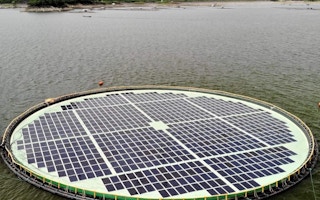Renewable energy generator SN Aboitiz Power-Magat (SNAP-Magat) has switched on its 200-kilowatt pilot floating solar power project, the first of its kind in the country, which the company hopes to expand to a commercial capacity after a 10-month testing period.
“This is the first non-hydro renewable energy (RE) project of SNAP, which is looking at other renewables and complementary technologies to expand the company’s renewable energy portfolio,” said Joseph Yu, SN Aboitiz Power (SNAP) president and chief executive officer.
During the pilot run, the project will initially be used to power the Magat hydropower plant. After the 10-month stress test and if the project proves to be able to withstand massive inflows and strong typhoons, the company will develop it to a bigger facility that can add up to the Luzon grid’s power needs.
“If successful, SNAP will look into scaling up the project so that the power generated may contribute to its renewable energy capacity and to the country’s energy security,” Yu said.
The company operates the SNAP-Magat located on the borders of Isabela and Ifugao provinces. It produces 360 to 388-megawatt from hydropower source.
“
If successful, SNAP will look into scaling up the project so that the power generated may contribute to its renewable energy capacity and to the country’s energy security.
Joseph Yu, president and chief executive officer, SN Aboitiz Power (SNAP)
Department of Energy (DOE) Secretary Alfonso Cusi said harnessing the country’s floating solar potential will help meet the country’s surging energy requirement.
Cusi said the country’s energy demand peaked to 11,000MW in June, an indication of the need to produce more energy to support its development needs.
“As the economy improves, we expect to have a higher demand for electricity. The government is exploring ways to increase energy supply to meet this demand,” Cusi said.
The floating solar power project currently sits in a portion of the 25,000-hectare Magat reservoir.
Cusi said even if just 50 per cent of the area will be utilised for a floating solar power, it will mean generating a significant amount of clean energy to support the country’s requirement.
National Irrigation Administration (NIA) chief Ricardo Visaya said their agency has raised concern over the conversion of agricultural land used for food production to large-scale solar power farms, which has caused a strain on food sustainability.
“If this [conversion] will continue, there will be no more areas to irrigate for food,” he said.
Visaya said the floating solar power plant will address the concerns of NIA and the Department of Agriculture on land use conversion issues.
“This can be replicated and help the country in its electricity demand problem,” Visaya said, noting the 350 dams nationwide which can be used for floating solar power plants.
SNAP-Magat partnered with Norway for the project.
“Norway is 95 percent reliant on renewable energy sources, which is good for the environment,” Norwegian Ambassador to the Philippines Bjorn Jahnsen said.
This story was published with permission from the Philippine News Agency.

















